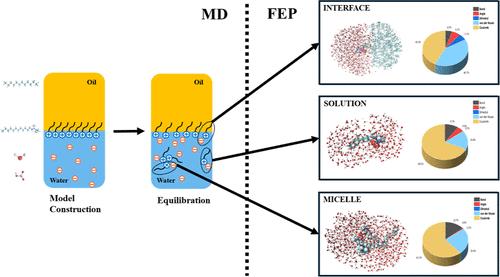油-水-表面活性剂体系中二氧化碳响应表面活性剂的分子相互作用和响应位置:分子动力学模拟与自由能扰动
IF 3.9
2区 化学
Q2 CHEMISTRY, MULTIDISCIPLINARY
引用次数: 0
摘要
了解二氧化碳响应表面活性剂的作用机理对提高其工业应用具有重要意义。传统的实验方法在确定系统内质子转移的确切位置以及准确描述分子间和分子内相互作用对这些物质的CO2响应性的影响方面面临挑战。为了解决这一问题,本研究采用分子动力学模拟和自由能摄动方法研究了响应co2的阳离子表面活性剂N ' -十二烷基-N,N-二甲基乙酰脒(DMAAH+)及其反离子碳酸氢盐离子在油水界面和胶束表面以及体水相中的质子转移过程。分子动力学模拟确定了系统中质子转移过程的潜在位置,并阐明了导致吉布斯自由能变化的相互作用类型。随后,利用自由能摄动计算了不同位置质子转移相关的吉布斯自由能变化。然后比较和分析了各种分子内和分子间相互作用的各自贡献。结果表明,去质子化过程在所有三个响应位置都不是热力学自发的。质子转移在油水界面上比在胶束表面更频繁地发生,而在整体水相中不太常见。这些发现增强了我们对控制二氧化碳响应性表面活性剂响应性的基本机制的理解,并为其在工业过程中的实际应用提供了有价值的见解。本文章由计算机程序翻译,如有差异,请以英文原文为准。

Molecular Interactions and Responsive Locations of CO2-Responsive Surfactants in an Oil–Water–Surfactant System: Molecular Dynamics Simulation and Free Energy Perturbation
Understanding the mechanism of a CO2-responsive surfactant is essential for enhancing its industrial applications. Conventional experimental methods face challenges in pinpointing the exact location of proton transfer within the system and in accurately describing the impact of intermolecular and intramolecular interactions on the CO2 responsiveness of such substances. To address this gap, this study employs molecular dynamics simulations and free energy perturbation methods to investigate the proton transfer process between a CO2-responsive cationic surfactant N′-dodecyl-N,N-dimethylacetamidinium (DMAAH+) and its counterion bicarbonate ion at the oil–water interface and micelle surface and in the bulk aqueous phase. Molecular dynamics simulations identified potential locations for the proton transfer process within the system and elucidated the types of interactions contributing to changes in Gibbs free energy. Subsequently, free energy perturbation was employed to calculate Gibbs free energy changes associated with proton transfer at different locations. The respective contributions of various intramolecular and intermolecular interactions were then compared and analyzed. It has been revealed that the deprotonation process is not thermodynamically spontaneous at all three responsive locations. The proton transfer occurs more frequently at the oil–water interface than at the micelle surface and is less common in the bulk aqueous phase. The findings enhance our understanding of the fundamental mechanisms governing the responsiveness of CO2-responsive surfactants and provide valuable insights for their practical application in industrial processes.
求助全文
通过发布文献求助,成功后即可免费获取论文全文。
去求助
来源期刊

Langmuir
化学-材料科学:综合
CiteScore
6.50
自引率
10.30%
发文量
1464
审稿时长
2.1 months
期刊介绍:
Langmuir is an interdisciplinary journal publishing articles in the following subject categories:
Colloids: surfactants and self-assembly, dispersions, emulsions, foams
Interfaces: adsorption, reactions, films, forces
Biological Interfaces: biocolloids, biomolecular and biomimetic materials
Materials: nano- and mesostructured materials, polymers, gels, liquid crystals
Electrochemistry: interfacial charge transfer, charge transport, electrocatalysis, electrokinetic phenomena, bioelectrochemistry
Devices and Applications: sensors, fluidics, patterning, catalysis, photonic crystals
However, when high-impact, original work is submitted that does not fit within the above categories, decisions to accept or decline such papers will be based on one criteria: What Would Irving Do?
Langmuir ranks #2 in citations out of 136 journals in the category of Physical Chemistry with 113,157 total citations. The journal received an Impact Factor of 4.384*.
This journal is also indexed in the categories of Materials Science (ranked #1) and Multidisciplinary Chemistry (ranked #5).
 求助内容:
求助内容: 应助结果提醒方式:
应助结果提醒方式:


